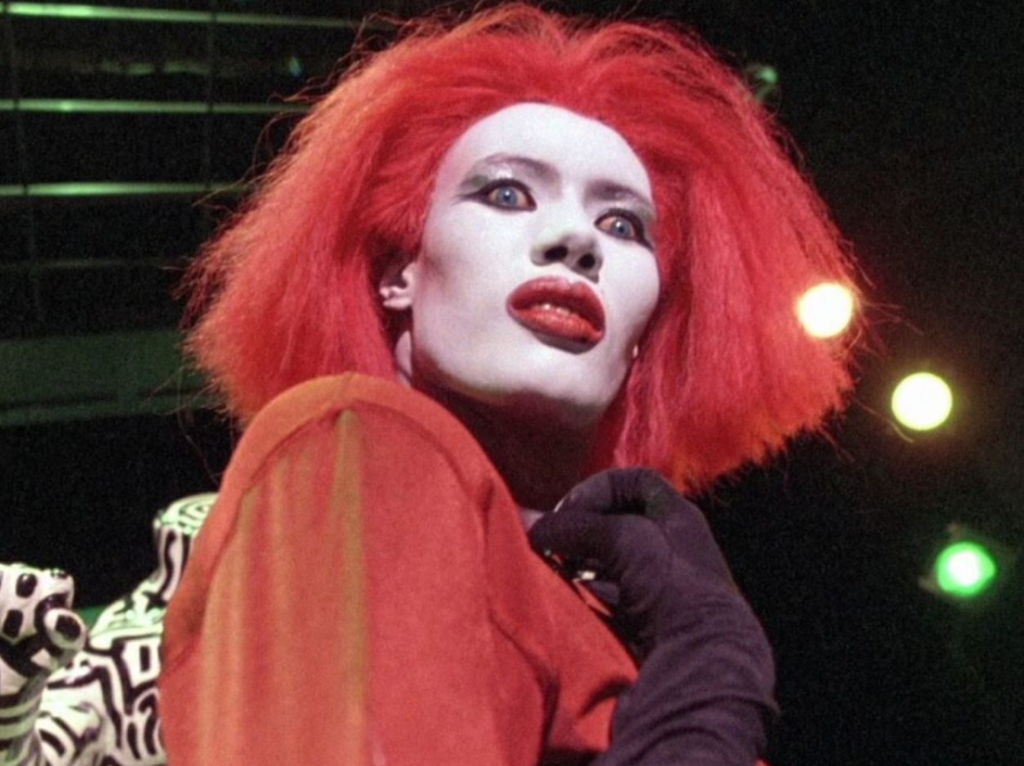Vamp’s (1986) vamp is played by Grace Jones. She’s positioned so prominently in the film’s advertisements — spookily resplendent in kabuki-esque makeup and a shock of a fire-engine-red wig — that if you didn’t know anything about the movie ahead of time, you might assume that this would be a Dracula moment for the singer-actress-model extraordinaire.
But, in a refrain common among the film’s detractors, Jones’ presence in the movie is a bit of a bait and switch. Her presence does loom heavily over the proceedings: she plays a succubus, Katrina, so ancient that the Egyptian-style crypt in which she passes the days can be presumed to be roughly from around the time of Cleopatra’s reign and so powerful that she seems to consider it a weakness to ever reveal a part of herself through speech. But her screen time is indeed negligible. Had it not been Jones doing the work, the part likely would not have made much of an impression. But because Katrina is played by Jones, an impression is made; I hardly found her not being in the movie as much as we’d like a detriment. It only adds to her cryptic mystique; it makes her feel even more threatening. Even when she isn’t around, you can still feel her.
Vamp also isn’t really about Katrina. It’s about two average-white-guy college friends, Keith and AJ (Chris Makepeace and Robert Rusler), who head to the “bad part of town” early in the movie in an attempt to hire a stripper as a way to get in the good graces of the fraternity to which they have designs on pledging. That part of town, always doused in woozy neon greens and pinks (Vamp can evoke classic Mario Bava movies), is bad, all right. But it doesn’t live up to stereotype. It turns out that not just the main strip club is run by vampires — with Katrina serving as an attraction ostensibly to better lure men on whom she can feed — but most of that pocket of town.
Keith and AJ, and also a pretty girl about their age (Dedee Pfeiffer) who maybe too is or maybe isn’t a vampire (she works as a waitress at the club), become moving targets. Some people have compared the movie to After Hours (1985), Martin Scorsese’s black comedy about a young man navigating what feels like real-life Hell in SoHo across what feels like a never-ending night. The comparisons are apt. Vamp, like After Hours, feels genuinely uncanny the more it goes on, and, though tempered with increasingly antic humor, also brims with menace.
Most of that menace comes courtesy of Jones, who appears in a new outfit for pretty much every scene she’s in. Sometimes she’s nearly nude and body-painted in white by Keith Haring; sometimes she’s in metallic, geometric headdresses and big, blood-red shoulder-padded vests. The through line is her usual sartorial cool — an impression of the clothes wearing her. The underlying ominousness underlying many of the images with which Jones is associated (I’m thinking of her iconic, if fraught, collaboration with the French photographer and graphic designer Jean-Paul Goude) spills over in a way it never really got to in the few movies in which she appeared, which, though not averse to casting her as the villainess, never saw her actually scary in a Béla Lugosi-esque sense.
It goes without saying that Jones doesn’t reach the heights of Lugosi in Dracula (1932) — she doesn’t have enough screen time to in the first place — and that Vamp doesn’t reach the heights of Dracula, either. But it’s a surprising triumph for teen horror, and a tribute to the otherworldliness Jones emits just being in the room.
